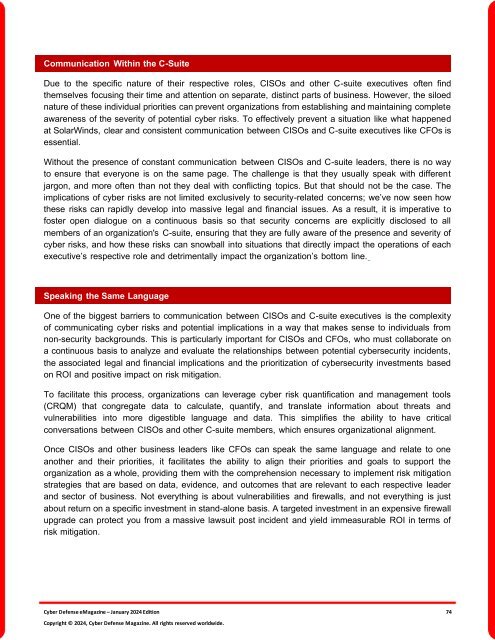The Cyber Defense eMagazine January Edition for 2024
Cyber Defense eMagazine January Edition for 2024 #CDM #CYBERDEFENSEMAG @CyberDefenseMag by @Miliefsky a world-renowned cyber security expert and the Publisher of Cyber Defense Magazine as part of the Cyber Defense Media Group as well as Yan Ross, Editor-in-Chief and many more writers, partners and supporters who make this an awesome publication! 201 page January Edition fully packed with some of our best content. Thank you all and to our readers! OSINT ROCKS! #CDM #CDMG #OSINT #CYBERSECURITY #INFOSEC #BEST #PRACTICES #TIPS #TECHNIQUES
Cyber Defense eMagazine January Edition for 2024 #CDM #CYBERDEFENSEMAG @CyberDefenseMag by @Miliefsky a world-renowned cyber security expert and the Publisher of Cyber Defense Magazine as part of the Cyber Defense Media Group as well as Yan Ross, Editor-in-Chief and many more writers, partners and supporters who make this an awesome publication! 201 page January Edition fully packed with some of our best content. Thank you all and to our readers! OSINT ROCKS! #CDM #CDMG #OSINT #CYBERSECURITY #INFOSEC #BEST #PRACTICES #TIPS #TECHNIQUES
You also want an ePaper? Increase the reach of your titles
YUMPU automatically turns print PDFs into web optimized ePapers that Google loves.
Communication Within the C-Suite<br />
Due to the specific nature of their respective roles, CISOs and other C-suite executives often find<br />
themselves focusing their time and attention on separate, distinct parts of business. However, the siloed<br />
nature of these individual priorities can prevent organizations from establishing and maintaining complete<br />
awareness of the severity of potential cyber risks. To effectively prevent a situation like what happened<br />
at SolarWinds, clear and consistent communication between CISOs and C-suite executives like CFOs is<br />
essential.<br />
Without the presence of constant communication between CISOs and C-suite leaders, there is no way<br />
to ensure that everyone is on the same page. <strong>The</strong> challenge is that they usually speak with different<br />
jargon, and more often than not they deal with conflicting topics. But that should not be the case. <strong>The</strong><br />
implications of cyber risks are not limited exclusively to security-related concerns; we’ve now seen how<br />
these risks can rapidly develop into massive legal and financial issues. As a result, it is imperative to<br />
foster open dialogue on a continuous basis so that security concerns are explicitly disclosed to all<br />
members of an organization's C-suite, ensuring that they are fully aware of the presence and severity of<br />
cyber risks, and how these risks can snowball into situations that directly impact the operations of each<br />
executive’s respective role and detrimentally impact the organization’s bottom line.<br />
Speaking the Same Language<br />
One of the biggest barriers to communication between CISOs and C-suite executives is the complexity<br />
of communicating cyber risks and potential implications in a way that makes sense to individuals from<br />
non-security backgrounds. This is particularly important <strong>for</strong> CISOs and CFOs, who must collaborate on<br />
a continuous basis to analyze and evaluate the relationships between potential cybersecurity incidents,<br />
the associated legal and financial implications and the prioritization of cybersecurity investments based<br />
on ROI and positive impact on risk mitigation.<br />
To facilitate this process, organizations can leverage cyber risk quantification and management tools<br />
(CRQM) that congregate data to calculate, quantify, and translate in<strong>for</strong>mation about threats and<br />
vulnerabilities into more digestible language and data. This simplifies the ability to have critical<br />
conversations between CISOs and other C-suite members, which ensures organizational alignment.<br />
Once CISOs and other business leaders like CFOs can speak the same language and relate to one<br />
another and their priorities, it facilitates the ability to align their priorities and goals to support the<br />
organization as a whole, providing them with the comprehension necessary to implement risk mitigation<br />
strategies that are based on data, evidence, and outcomes that are relevant to each respective leader<br />
and sector of business. Not everything is about vulnerabilities and firewalls, and not everything is just<br />
about return on a specific investment in stand-alone basis. A targeted investment in an expensive firewall<br />
upgrade can protect you from a massive lawsuit post incident and yield immeasurable ROI in terms of<br />
risk mitigation.<br />
<strong>Cyber</strong> <strong>Defense</strong> <strong>eMagazine</strong> – <strong>January</strong> <strong>2024</strong> <strong>Edition</strong> 74<br />
Copyright © <strong>2024</strong>, <strong>Cyber</strong> <strong>Defense</strong> Magazine. All rights reserved worldwide.

















